
Gran Via de les Corts Catalanes, more simply known as Gran Via, is one of Barcelona's major avenues. With a length of 13.1 km (8.1 mi), it is the longest street in Catalonia and the 2nd longest in Spain, after Gran Vía de la Manga, in La Manga del Mar Menor, but is the one with most street numbers in Spain.

Avinguda Diagonal is the name of one of Barcelona's broadest and most important avenues. It cuts the city in two, diagonally with respect to the grid pattern of the surrounding streets, hence the name.
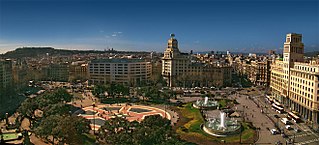
Plaça de Catalunya is a large square in central Barcelona that is generally considered to be both its city centre and the place where the old city and the 19th century-built Eixample meet.
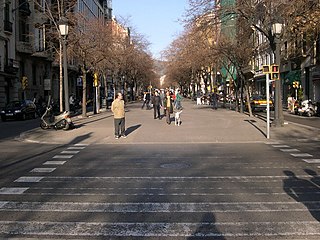
Rambla de Catalunya is a major street in the Eixample district of central Barcelona, Spain. It is one of the city's trendiest streets, with many international fashion shops, and is lined with lime trees.

Via LaietanaVía Layetana in Spanish, is a major thoroughfare in Barcelona, Catalonia, Spain, in the Ciutat Vella district. The avenue runs from Plaça Urquinaona to Plaça d'Antonio López, by the seafront, and separates the neighbourhoods of the old city it has on either side: La Ribera/El Born and Sant Pere on one and Barri Gòtic on the other. Besides being always overcrowded with both locals and tourists attracted by its Modernista Art Nouveau, Art Déco, and Noucentista neo-classical architecture, in addition to its nearness to the Ramblas and the quiet pedestrian streets of Barri Gòtic, Via Laietana hosts the headquarters of a number of banks and institutions.

Passeig de Sant Joan is a major avenue in the Eixample and Gràcia districts of Barcelona. It was named after an older street carrying this name, also known as Passeig Nou, built in 1795 around the glacis of the Ciutadella fortress.

Plaça de les Glòries Catalanes, most often shortened to Glòries, is a large square in Barcelona, first designed by Ildefons Cerdà to serve as the city centre in his original urban plan, but nowadays relegated to quite a secondary position. It is located in the Sant Martí district, bordering Eixample, at the junction of three of the city's most important thoroughfares: Avinguda Diagonal, Avinguda Meridiana and Gran Via de les Corts Catalanes. Currently it serves largely as a roundabout of elevated highways. However, beginning in the early 2000s, and as of 2007, revamping project for Glòries has started, which is aimed to give the square a new role in Barcelona and revitalize the northern districts of the city, under the name 22@. These plans supplement other large-scale plans in Sagrera and the Fòrum area. The first installment of this project was the construction of the Torre Agbar skyscraper.

Plaça d'Espanya is one of Barcelona's most important squares, built on the occasion of the 1929 Barcelona International Exposition, held at the foot of Montjuïc, in the Sants-Montjuïc district.

Urquinaona is a station in the Barcelona Metro network, served by TMB lines L1 and L4. One of the metro stations in the city centre, and one of the busiest, it's located underneath Ronda de Sant Pere and Via Laietana, next to Plaça Urquinaona - after which it is named - in the Eixample. It can be accessed from Plaça Urquinaona and Via Laietana.

Universitat is a Barcelona Metro station named after Plaça de la Universitat, split between Eixample and Ciutat Vella districts of Barcelona, where the station is located in. This square holds the historical building of Universitat de Barcelona, celebrated for its neo-gothic style. The station is accessible for disabled persons since 1995, when Barcelona Metro line 2 opened its platforms. It is served by TMB-operated Barcelona Metro lines L1 and L2.

The Barcelona–Vallès Line is an unconnected standard gauge rapid transit and commuter railway line linking Barcelona with Sabadell and Terrassa via the Collserola mountain range, in Catalonia, Spain. Its name refers to the Catalan historical region of Vallès, whereby most part of the line runs. Plaça de Catalunya station serves as the Barcelona terminus of the line, where almost all its trains either start or terminate. The line then continues northwards and branches off twice before leaving the city limits. Its main route splits in two in Sant Cugat del Vallès, forming two major branches to Sabadell and Terrassa. It has 40 passenger stations in operation and a total line length of 48.1 kilometres (29.9 mi).

Avinguda del Paral·lel is one of the main streets of the city of Barcelona, dividing Ciutat Vella, Eixample and Sants-Montjuïc districts. It receives this name because it is parallel to the Equator. It runs from Plaça d'Espanya, where the city's exhibition halls are located, to the seafront, Plaça de la Carbonera and the passenger ship port, dividing the neighbourhood of Poble Sec, on the side of Montjuïc, from the neighbourhoods of Sant Antoni and El Raval. It was officially inaugurated on October 11, 1894.
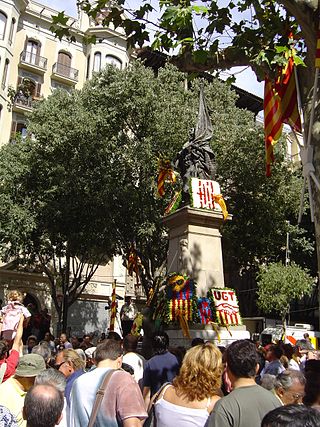
Ronda de Sant Pere is a thoroughfare in central Barcelona, Catalonia, Spain, one of the main roads in the lower side of Dreta de l'Eixample, part of the Eixample district. It runs from the Arc de Triomf, in Passeig de Lluís Companys, through Plaça Urquinaona towards Plaça de Catalunya, where the medieval city walls stood before the construction of Eixample. After Plaça de Catalunya it becomes Ronda de la Universitat.
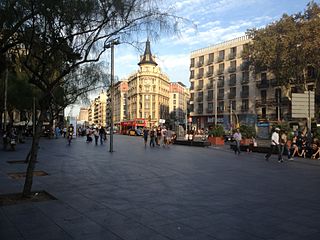
Ronda de la Universitat is a major thoroughfare of central Barcelona, Catalonia, Spain, in lower side of the Dreta de l'Eixample, in the Eixample district. It links two of the city's three main squares, running from Plaça de Catalunya towards Plaça Universitat. There it meets Gran Via de les Corts Catalanes and Ronda de Sant Antoni begins. It's essentially the same street as Ronda de Sant Pere, which follows it right after Plaça de Catalunya. As the other ronda, it follows the original outline of the medieval city walls, particularly the wall of Tallers, above the area nowadays known as Raval, where a road called Carrer de Tallers runs partially parallel to it. Ronda de la Universitat was paved in 1872. It takes its name from the Universitat de Barcelona, which has had its main building at Plaça Universitat since the 19th century. Before its current name was approved in 1989, its official name was in Spanish: Universidad. The Biblioteca Judicial de Catalunya is on this street.
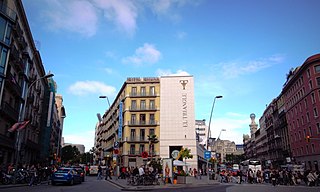
Carrer de Bergara is a short street in central Barcelona, stretching from Plaça Catalunya towards Carrer de Pelai. It's in the Eixample district. It's named after the Basque city of Bergara, where an armistice was signed at the end the First Carlist War in 1839. The name of the street was approved in 1900. The street is home to a number of restaurants, cafes, and hotels.

Plaça de Mossèn Jacint Verdaguer is a square in the Eixample district of Barcelona, Catalonia, Spain. It lies in the intersection between Avinguda Diagonal, the city's main avenue, and Passeig de Sant Joan, in Dreta de l'Eixample, not far from the Sagrada Família.

The Plaça de la Universitat is one of Barcelona's central squares, at the border between the districts of Eixample and Ciutat Vella. It is located at the intersection of Gran Via de les Corts Catalanes, Carrer d'Aribau and Ronda de Sant Antoni. It is also just west of Plaça de Catalunya, to which it is linked by the Ronda de la Universitat and Carrer de Pelai.

Dreta de l'Eixample is a neighborhood in the Eixample district of Barcelona, Catalonia (Spain). It is located east of Carrer de Balmes. It includes Plaça de Catalunya, the centre of the city, and the upscale streets Rambla de Catalunya and Passeig de Gràcia. It is the bourgeois neighborhood of the city, which makes the majority of its population belong to the upper class of Barcelona. Dreta de L'Eixample is one of the most luxurious neighborhoods of Barcelona.

Avinguda de la Llum is a now-closed underground mall in Barcelona, the first one of its kind to open in Europe, open between 1940 and 1990, on a 2000 square-metre site built in 1929 and boasting 68 commercial establishments, including a movie theater. It was underneath Carrer de Pelai, between Plaça de Catalunya, Carrer de Balmes, Carrer de Bergara and Plaça de la Universitat, upstairs of the Ferrocarrils de la Generalitat de Catalunya (FGC) station Catalunya, between its vaults and the street.

Plaça de Tetuan, known in Spanish as Plaza de Tetuán, is a major square in Barcelona. It is in Fort Pienc, in the central district of Eixample, at the busy intersection of Gran Via de les Corts Catalanes and Passeig de Sant Joan. The square is named after the 1860 Battle of Tétouan, the siege and occupation of the Moroccan city of Tetuan by general Joan Prim and Catalan volunteers. It was formerly called Hermenegildo Giner de los Ríos.





















